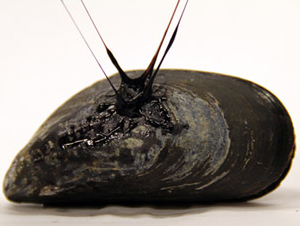Citations
By Burke Frank, ’11
Image courtesy Tara Fadenrecht, Niels Holten-Andersen
Pint-sized predator
A 230-million-year-old carnivore discovered in Argentina, weighing a mere 10 to 15 pounds, provides a glimpse into the beginning of the dinosaur era. Named Eodromaeus, or “dawn runner,” this reptile, says Chicago paleontologist Paul Sereno, is the earliest carnivorous dinosaur discovered, belonging to a family that culminated in Tyrannosaurus rex near the end of the Mesozoic Age. Sereno and his Argentine colleagues published findings in the January 14 Science that were unusually complete, because the team was lucky enough to find two Eodromaeus fossils side by side, allowing for a near-complete skeleton. Eodromaeus would have lived among competing land dwellers, including protomammal and squat-lizard reptiles, and could provide clues as to why dinosaurs rose to dominance over the course of millions of years.
Fishy fingers
The elephant fish, a relative of the shark found in Australian waters, has unexpected genetic similarities with mammals, according to Chicago organismal biologist Neil Shubin and colleagues from the United Kingdom, Australia, and New Zealand. A scuba expedition collected embryos of the rare species, and researchers found that the fish’s skeletal gill covers were formed from the same genetic process as mammalian fingers and toes. The timing and placement of that gene’s expression determines the dramatic anatomical differences. Evolutionary biologists have long suspected that the efficiency of natural selection could produce parallels between mammals and holocephalans such as elephant fish, which have cartilage-based skeletons and appendages. Finding their eggs, though, has proved daunting: holocephalans lay them on the ocean floor. The researchers published their findings January 10 online in the Proceedings of the National Academy of Sciences.
Flu fighter
The 2009 H1N1 “swine flu” pandemic, which infected 60 million and hospitalized 250,000 patients in the United States, has been helpful for research. In the January 10 Journal of Experimental Medicine, Medical Center immunologist Patrick Wilson and collaborators from Chicago, Emory University, and the Centers for Disease Control reported that people infected with H1N1 produced antibodies capable of fighting many strains of flu, including the famously deadly 1918 strain. Experiments indicate that’s because H1N1 antibodies bind not to the virus’s annually mutating “head” region but instead to its “stalk,” a core element that dozens of strains share. Wilson called the finding “the Holy Grail for flu-vaccine research.” A one-time vaccine targeting the flu’s stalk, researchers suggest, might protect the body as effectively as yearly injections
Sticky stuff

Mussels aren’t just good eats: imitating their self-healing adhesive, Chicago researchers have produced a synthetic substance that can bind materials underwater as well as on dry land. The self-assembly process responsible for the gel’s tenacity is poorly understood, but Chicago chemist Ka Yee Lee, chemistry postdoc Niels Holten-Andersen, and Northwestern scientists produced a polymer—a long molecular chain—that is a remarkably stable copy of its natural counterpart. Described in the January 24 Proceedings of the National Academy of Sciences, the invention uses a mixture of the polymer and metal ions in a high-pH solution. The solution creates in moments a gel that shellfish evolved in response to pounding ocean waves and tidal basins. The material could find uses as diverse as a surgical adhesive or as a bond for underwater machinery.
Return to top
